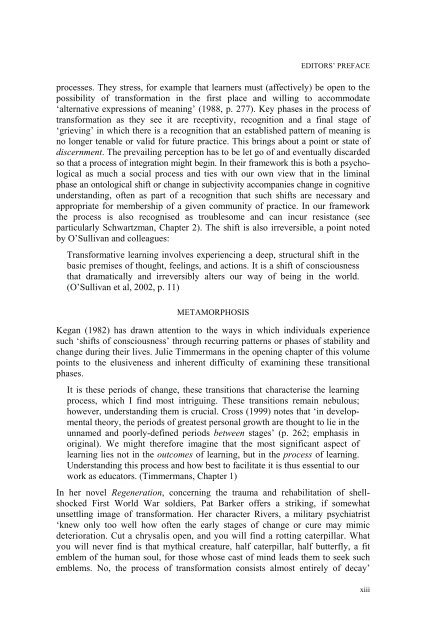EDITORS’ PREFACEprocesses. They stress, for example that learners must (affectively) be open to thepossibility of transformation in the first place <strong>and</strong> willing to accommodate‘alternative expressions of meaning’ (1988, p. 277). Key phases in the process oftransformation as they see it are receptivity, recognition <strong>and</strong> a final stage of‘grieving’ in which there is a recognition that an established pattern of meaning isno longer tenable or valid for future practice. This brings about a point or state ofdiscernment. The prevailing perception has to be let go of <strong>and</strong> eventually discardedso that a process of integration might begin. In their framework this is both a psychologicalas much a social process <strong>and</strong> ties with our own view that in the liminalphase an ontological shift or change in subjectivity accompanies change in cognitiveunderst<strong>and</strong>ing, often as part of a recognition that such shifts are necessary <strong>and</strong>appropriate for membership of a given community of practice. In our frameworkthe process is also recognised as troublesome <strong>and</strong> can incur resistance (seeparticularly Schwartzman, Chapter 2). The shift is also irreversible, a point notedby O’Sullivan <strong>and</strong> colleagues:Transformative <strong>learning</strong> involves experiencing a deep, structural shift in thebasic premises of thought, feelings, <strong>and</strong> actions. It is a shift of consciousnessthat dramatically <strong>and</strong> irreversibly alters our way of being in the world.(O’Sullivan et al, 2002, p. 11)METAMORPHOSISKegan (1982) has drawn attention to the ways in which individuals experiencesuch ‘shifts of consciousness’ through recurring patterns or phases of stability <strong>and</strong>change during their lives. Julie Timmermans in the opening chapter of this volumepoints to the elusiveness <strong>and</strong> inherent difficulty of examining these transitionalphases.It is these periods of change, these transitions that characterise the <strong>learning</strong>process, which I find most intriguing. These transitions remain nebulous;however, underst<strong>and</strong>ing them is crucial. Cross (1999) notes that ‘in developmentaltheory, the periods of greatest personal growth are thought to lie in theunnamed <strong>and</strong> poorly-defined periods between stages’ (p. 262; emphasis inoriginal). We might therefore imagine that the most significant aspect of<strong>learning</strong> lies not in the outcomes of <strong>learning</strong>, but in the process of <strong>learning</strong>.Underst<strong>and</strong>ing this process <strong>and</strong> how best to facilitate it is thus essential to ourwork as educators. (Timmermans, Chapter 1)In her novel Regeneration, concerning the trauma <strong>and</strong> rehabilitation of shellshockedFirst World War soldiers, Pat Barker offers a striking, if somewhatunsettling image of transformation. Her character Rivers, a military psychiatrist‘knew only too well how often the early stages of change or cure may mimicdeterioration. Cut a chrysalis open, <strong>and</strong> you will find a rotting caterpillar. Whatyou will never find is that mythical creature, half caterpillar, half butterfly, a fitemblem of the human soul, for those whose cast of mind leads them to seek suchemblems. No, the process of transformation consists almost entirely of decay’xiii
LAND ET AL(Barker, 1991, p.184). The theme of elusiveness in the process is continued here butalso the necessity of discarding the former state. As the American-French writerAnais Nin observed, ‘To change skins, evolve into new cycles, I feel one has tolearn to discard. If one changes internally, one should not continue to live with thesame objects. They reflect one’s mind <strong>and</strong> the psyche of yesterday. I throw awaywhat has no dynamic, living use.’ (Nin, 1971, p. 26). But as Rebecca Solnit pointsout, as yet, ‘We have not much language to appreciate this phase of decay, thiswithdrawal, this era of ending that must precede beginning. Nor of the violenceof the metamorphosis, which is often spoken of as though it were as graceful asa flower blooming ... The process of transformation consists mostly of decay <strong>and</strong>then of this crisis when emergence from what came before must be total <strong>and</strong>abrupt’. (Solnit, 2006, pp.81–3). The chapters that follow in this volume attemptjust that, an articulation of what such transformation – literally a going beyondone’s extant form – entails. And, as we will see in the following pages, thetransformation will always be determined to some extent by its disciplinary, orinterdisciplinary, context. As Crainton emphasises:xivTransformative <strong>learning</strong> is not independent of content, context, or a discipline.It’s not an ‘add on’ to a course. It is a way of making meaning of knowledgein a discipline in a way that students don’t passively accept <strong>and</strong> believe whatthey are told or what they read, but rather engage in debate, discussion, <strong>and</strong>critical questioning of the content. Promoting transformative <strong>learning</strong> is a partof ‘covering’ content. (Kelly <strong>and</strong> Crainton, 2009, p. 1)Transformative <strong>learning</strong>, she argues, can be promoted by using ‘any strategy,activity, or resource that presents students with an alternative point of view’. Thesemight include ‘readings from different perspectives, field experiences, videos, roleplays, simulations, <strong>and</strong> asking challenging questions’ all of which have the capacityto effect transformative <strong>learning</strong>. ‘The educator needs to create an environmentin which critical reflection <strong>and</strong> questioning norms is supported <strong>and</strong> encouraged’(ibid). What would seem to be the enemy of transformative <strong>learning</strong>, however, isdidacticism or any form of coercion. This is persuasively expressed by theAmerican theologian <strong>and</strong> teacher Walter Brueggemann. The elegance of hisargument merits quoting in full:We now know (or think we know) that human transformation (the waypeople change) does not happen through didacticism or through excessivecertitude but through the playful entertainment of another scripting of realitythat may subvert the old given text <strong>and</strong> its interpretation <strong>and</strong> lead to theembrace of an alternative text <strong>and</strong> its redescription of reality. Very fewpeople make important changes in their description of the world abruptly.Most of us linger in wistfulness, notice dissonance between our experience<strong>and</strong> the old text, <strong>and</strong> wonder if there is a dimension to it all that has beenmissed. Most of us will not quickly embrace an alternative that is given usin a coercive way. Such coercion more likely makes us defend the old <strong>and</strong>, ingeneral, become defensive. Victor Turner noted that there is an in-betweentime <strong>and</strong> place in social transformation <strong>and</strong> relocation, which he termed
- Page 1 and 2: EDUCATIONAL FUTURES: RETHINKING THE
- Page 3 and 4: EDUCATIONAL FUTURESRETHINKING THEOR
- Page 5 and 6: A C.I.P. record for this book is av
- Page 7 and 8: TABLE OF CONTENTS10. Threshold Conc
- Page 9 and 10: Pax Intrantibus Salus Exeuntibus. L
- Page 11 and 12: LAND ET ALstudents experience diffi
- Page 13: LAND ET ALModePreliminalLiminalPost
- Page 17 and 18: LAND ET ALvariations arising from t
- Page 19 and 20: LAND ET ALform of a model of concep
- Page 21 and 22: LAND ET ALQuestions of intersection
- Page 24 and 25: EDITORS’ PREFACEstudents bring to
- Page 26 and 27: EDITORS’ PREFACEconcepts in the f
- Page 28 and 29: EDITORS’ PREFACEIn the final illu
- Page 30 and 31: EDITORS’ PREFACEhence becomes a n
- Page 32 and 33: EDITORS’ PREFACElearning. This th
- Page 34 and 35: EDITORS’ PREFACEa lens or ‘way
- Page 36 and 37: EDITORS’ PREFACEHence learning is
- Page 38 and 39: EDITORS’ PREFACEthe Communitas, w
- Page 40 and 41: EDITORS’ PREFACEBuilding on these
- Page 42 and 43: EDITORS’ PREFACECousin, G. (2009)
- Page 44 and 45: DAVID PERKINSFOREWORDEntrance…and
- Page 46: FOREWORDMeyer, J.H.F., Land, R. & D
- Page 50 and 51: JULIE A. TIMMERMANS1. CHANGING OUR
- Page 52 and 53: CHANGING OUR MINDSKegan’s (1982)
- Page 54 and 55: CHANGING OUR MINDSKegan describes e
- Page 56 and 57: CHANGING OUR MINDSIn fact, Kegan an
- Page 58 and 59: CHANGING OUR MINDSat the epistemolo
- Page 60 and 61: CHANGING OUR MINDSMight a learner r
- Page 62 and 63: CHANGING OUR MINDSreveals an additi
- Page 64 and 65:
CHANGING OUR MINDSBendixen, L. D.,
- Page 66:
CHANGING OUR MINDSSibbett, C., & Th
- Page 69 and 70:
SCHWARTZMANScholarship in liminalit
- Page 71 and 72:
SCHWARTZMANTC: the entityThe term T
- Page 73 and 74:
SCHWARTZMANA resource for teaching
- Page 75 and 76:
SCHWARTZMANunprecedented to attract
- Page 77 and 78:
SCHWARTZMANspectrum of scholarship
- Page 79 and 80:
SCHWARTZMANrupture and phenomenolog
- Page 81 and 82:
SCHWARTZMANfield(s) of one’s cons
- Page 83 and 84:
SCHWARTZMAN36DATA: PARTICULARS GIVI
- Page 85 and 86:
SCHWARTZMANchallenge than interpret
- Page 87 and 88:
SCHWARTZMANStrategies for Teaching:
- Page 89 and 90:
SCHWARTZMANThey are redefined here
- Page 91:
SCHWARTZMANLoder, J. (1981). The tr




